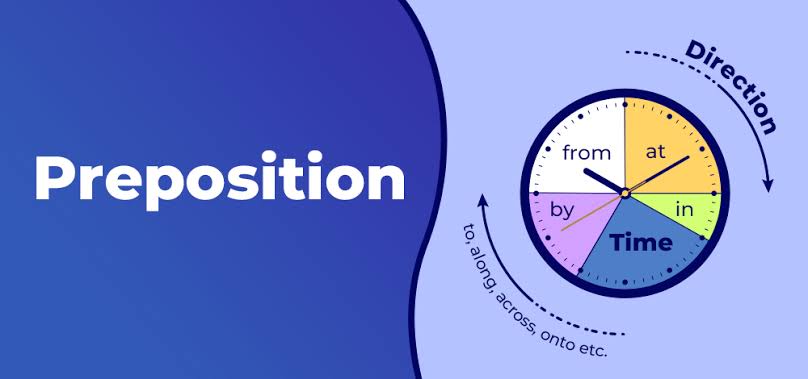
Prepositions:
A preposition is a word that links nouns, pronouns, or phrases to other words in a sentence. It shows the relationship between its object (the noun or pronoun it introduces) and other parts of the sentence, often indicating time, place, direction, cause, manner, or instrument.
Key Functions of Prepositions
- Time: Prepositions help describe when something happens.
- Examples: at, on, in, before, after, during.
- At: “The meeting is at 3 PM.”
- On: “The event is on Monday.”
- In: “She was born in 1990.”
- Examples: at, on, in, before, after, during.
- Place: Prepositions describe the location or position of something.
- Examples: at, on, in, under, beside, between, behind, above, below.
- At: “We are at the park.”
- On: “The book is on the table.”
- In: “The cat is in the box.”
- Under: “The shoes are under the bed.”
- Between: “The coffee shop is between the bank and the library.”
- Examples: at, on, in, under, beside, between, behind, above, below.
- Direction or Movement: Prepositions can show movement or direction towards a place.
- Examples: to, into, onto, from, toward, across.
- To: “She is going to the store.”
- Into: “The bird flew into the cage.”
- Across: “He walked across the street.”
- Examples: to, into, onto, from, toward, across.
- Cause, Reason, or Purpose: Prepositions show the reason or purpose behind an action.
- Examples: for, because of, due to, in order to.
- For: “She studied for the test.”
- Because of: “The event was canceled because of rain.”
- In order to: “He woke up early in order to catch the bus.”
- Examples: for, because of, due to, in order to.
- Manner or Instrument: Prepositions can express how an action is performed or what tool is used.
- Examples: by, with, through.
- By: “She traveled by car.”
- With: “He wrote the letter with a pen.”
- Through: “The ball went through the window.”
- Examples: by, with, through.
- Other Relationships: Prepositions can also describe other relationships like possession, comparison, or accompaniment.
- Examples: of, with, about, like.
- Of: “The color of the sky is blue.”
- With: “She is talking with her friend.”
- About: “He is speaking about the project.”
- Like: “She sings like a professional.”
- Examples: of, with, about, like.
Types of Prepositions

- Simple Prepositions: These are single words that show relationships between their object and other parts of the sentence.
- Examples: at, by, with, on, in, to, from, for.
- Compound Prepositions: These are combinations of simple prepositions with other words, often forming a single unit of meaning.
- Examples: in front of, because of, in spite of, on behalf of.
- Phrasal Prepositions: These are phrases made up of prepositions and their objects, typically a noun or pronoun.
- Examples: in addition to, by means of, in place of.
Prepositions and Their Objects
- The object of a preposition is typically a noun or pronoun, and it follows the preposition to complete the prepositional phrase. A prepositional phrase includes the preposition and its object.
- Example: “The keys are on the table.”
- On is the preposition, and the table is the object of the preposition, forming the prepositional phrase.
- Example: “The keys are on the table.”
Preposition Usage
- Prepositions in Questions: Prepositions often come at the end of questions when referring to a noun or pronoun.
- Example: “What are you talking about?”
- In formal writing, it’s preferred to avoid ending a sentence with a preposition. However, this rule is often relaxed in casual speech and writing.
- Prepositions with Verbs (Phrasal Verbs): Some verbs are followed by prepositions that change the meaning of the verb.
- Example: “She looks after her grandmother.”
- Here, “looks after” means “takes care of,” demonstrating how prepositions can alter a verb’s meaning.
- Example: “She looks after her grandmother.”
Common Prepositional Mistakes
- Confusing “in” vs. “on”:
- In refers to being inside something (e.g., “The keys are in the drawer”).
- On refers to being on the surface of something (e.g., “The book is on the table”).
- Overuse of “of”: Sometimes, “of” is unnecessarily used in expressions where a simpler preposition would be more appropriate.
- Correct: “The color of the sky.”
- Avoid: “The color of the sky of the morning.”
- Using the wrong preposition with verbs: Some verbs require specific prepositions, and using the wrong one can lead to confusion.
- Correct: “She is waiting for the bus.”
- Incorrect: “She is waiting on the bus.”
Conclusion
Prepositions are crucial for expressing relationships in sentences, whether it’s about time, place, direction, reason, or manner. Understanding prepositions and their functions can significantly improve sentence structure and clarity. Using prepositions correctly helps to convey precise meaning and enhances the quality of communication.

Narayan
Nice Explanation of proposition and it’s Examples.